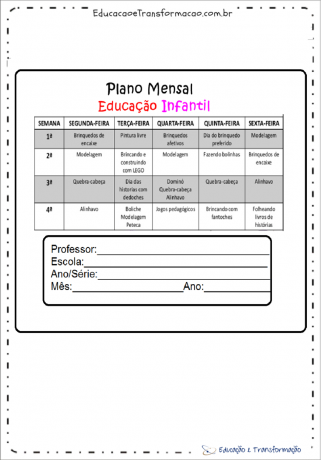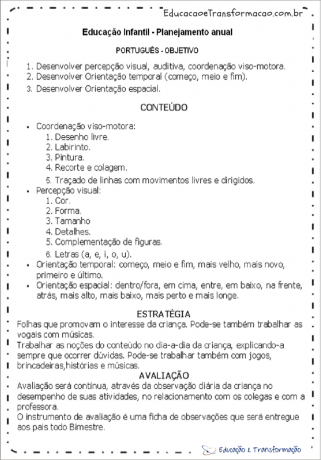We have gathered in this publication some models, tips and suggestions for your Early childhood education lesson plan.
O early childhood education lesson plan is an essential element for the planning diary of activities that will be developed by the teacher in the classroom. class during the year. It is the responsibility of the education professional, who will outline the learning objectives and how they will be achieved.
O planning it is a constant need in all areas of human activity. Planning is analyzing a reality and predicting alternative forms of action to overcome difficulties or reach desired goals.
In short, planning consists in predicting and deciding on what we intend to accomplish; what do we do; how are we going to do it; what and how should we analyze the situation in order to verify that what we intend has been achieved. The plan, on the other hand, is the result, it is the outline of the conclusions resulting from the planning process, which may or may not take a written form.
The planning must include a forecast of teaching activities, as well as their review and adaptation throughout the school year, according to the needs and development of each class. It is necessary for the professional to set the goals keeping in mind what will be taught, how it will be done and carry out a daily evaluation to find errors and fix them, always aiming at greater productivity and efficiency in the classroom. class.
Planning is imagining the class even before it happens and that's exactly why we selected these wonderful models for your Early childhood education lesson plan:
Index
All these aspects are articulated through an interdisciplinary pedagogical practice, always seeking the integration of activities, so that there is no loss of the real social value of each area of the knowledge.
The formation of habits and attitudes (hygiene, posture, good manners, food, leisure, clothing, rest, study, sociability and responsibility) aims stimulate the educational process of student independence and also facilitate their social integration and is integrated into all curriculum components during the year.
The content is based on the child's daily life and the activities are diversified by study area, but integrated through a topic of interest to the child or suggested by the teacher, who has full autonomy to create and recreate all of their activities.
In every administrative process, the role of the Teacher it's very important:

Routine provides a sense of security. Even at home, the child exposed to a routine is calmer because he knows what will happen next. At school, an environment in which she naturally feels less protected, which is often the first place for socializing outside the family, this is even more urgent.






Source: http://educacrianca.com.br

Contents: Graphics; Balance and concentration.
Goals:
Duration: 02 hours
Activity: poster of circles.
Materials: crayons, brown paper, gouache paint, brush.
Development:
Assessment: Students recognized the geometric circle figure, and the colors they painted, thus developing their concentration.
Contents: Balance and concentration; Food.
Goals:
Activity: Are we going to help the farmer plant the seeds?
Material: brush, paint, sandpaper
Work development:
Assessment: Students reflected on their diet and the care they should have with it.
Contents: Spoken language/body language/mathematical language.
Goals:
Activity: each monkey on its branch
Development:
Application with the conversation wheel about games, what they like to play and if they like to know new games. We made several chalk circles on the floor and asked students to walk on them. In the living room, we made a circle. We explained to the students how it was to be done. The hunter chosen by the teacher naps in the center of the wheel, while the monkeys spin around him, taking care not to make any noise. Suddenly, the hunter wakes up and screams: every monkey on his branch! All children will run and enter a circle so they don't get caught. When the hunter thinks he's been on a branch for a long time, he'll give the order again, for everyone to look for another branch, having a better chance of catching a monkey. We started the game, Each monkey on its branch, and when finished, we made a count of how many monkeys were caught in the game.
Assessment: Students were able to develop their orality, interacting with all colleagues, in addition to the attention they had to play the game.
Contents: Mathematics/Body language/ Oral language/ Music Balance and concentration.
Goals:
Activity: Bunny comes out of the hole;
Material: hula hoop
Development: We started with an informal conversation of how many students are in the room, they participated by counting. After we explain the game. It is necessary to put hula hoops on the floor, which will be the burrows. Each child is a bunny and one of us was “his wolf”. The children sang as they strolled through the room: Let's walk in the woods while your wolf doesn't come. They go to where the wolf is and ask: is your wolf? Twice the wolf said he was busy doing something. Then when the children came back again the wolf said: the wolf is ready! And he went out picking up the children who were out of the dens. We repeated the joke a few times, and sat down to talk about the part they liked the most about the game, who were the characters and how many bunnies did the wolf manage to catch?
Assessment: The students, when carrying out the activity, developed attention and orality and body expression.
Contents: oral language/body language/mathematics language
Goals:
Awaken the precautions that should be taken in relation to protection from the sun; Develop the notion of quantity.
Duration: 2 hours
Activity 1: “Zezé” story
Development: Wheel informal conversation to present the story; “Zezé”. “Look what happened, My snowman melted. The eyes, the ears, the mouth and the nose, Even the neck disappeared. The hands, arms and belly, They ended up on the ground. Seeing the sun! You abused! From Zezé and nothing is left”!!! After finishing the story, we asked questions about who Zezé was, what happened to him, why? What were the parts of Zezé's body that disappeared and how many were they? We talked about the importance of protecting yourself from the sun, and its effects on your skin and health.
Activity 2:
On letter sheets we asked students to draw the Zezé snowman, when they finished they were displayed on the clothesline in the classroom.
Assessment: Students were able to interact with their peers, and report the sequence of events that happened in the story, thus developing their concentration.
Contents: Spatial organization: before/during and after, today/yesterday/tomorrow.
Objective:
Provide students with a better understanding of the place where they live, perceiving themselves as part of it.
Duration: 02 hours
Activity: Brief history of the city
Development: Briefly telling the history of the city of Carapebus reported in a book of the municipality; Conversation Wheel; We asked the children to tell what they liked most about their city and what they would like it to have. They participated by reporting their ideas, after we handed over a sheet for them to draw their city. Each one did as they saw it. When everyone had finished, we made a collective poster with the fish that gave rise to the city's name, which we displayed in the classroom for everyone to see.
Assessment: By creating a collective poster, the children demonstrated their ability to interact and respect each other.
Contents: Water: uses, economy and waste;
Goals:
Make the class understand that water is a scarce resource on the planet and that the irresponsible use of this resource can harm the survival of living beings.
Duration: 2 hours
Activity: Poster
Development: Wheel of conversation about the water used by them, we asked questions like? "What household activities do you know that need water?" As suggestions emerged, noted on a poster, the list contained items such as washing clothes, dishes and hands, bathing and brushing teeth. We talked about these activities to help the class realize that families use water in a similar way. We booked some magazines where the children looked for pictures of the actions and pasted them on the posters. We asked the class to draw two drawings, one representing waste and the other showing how we can save water. We distributed images from newspapers and magazines that showed waste and water savings they were mixed and we asked the children to separate the material into two groups, according to the good and bad use of the resource. At the end of the selection, the children, with our help, placed the images on the poster separately.
Assessment: We found that the group understood that certain human activities cause water waste and that this loss must be avoided.
___________________________________________________
Contents: Environment
Objective: Awaken the formation of values and attitudes with the environment in which they live; Understand the importance of preserving the environment; encourage care for nature.
Duration: 2 hours
Activity: Story “At the end of the world the end changes”
Development: We chat informally and ask them what the environment is? After the answers, we guided the questions to give them information: How is the environment in which we live? What do you do to help this environment? After the round of conversation we told the story “At the end of the world, the end changes”. After the story we asked them to draw what end they wanted for the environment in which they live, and we build a cardboard world to represent waters and forests and men and animals.
Assessment: They understood the importance of taking care of the environment in which they live, respecting their environment.
Contents: Free drawing, painting, encourage and develop the habit of drawing, thus stimulating the child's fantasy.
Objective:
Duration: 2 hours
Activity: Art
Material: A4 Sheet, Toothpaste, Aniline, Plastic Cup
Development: We talked with students about colors, and the art of transforming them, as well as making them. In the classroom we put the toothpaste in plastic cups and dyed them with aniline of different colors, we gathered the children so they could use each other's colors and we handed over a sheet of A4 paper and asked them to draw a picture using their fingers and the ink made with the paste. tooth. We looked at the texture differences, then asked why this design. They participated, answering that it was because there was a lot more ink in one drawing than the other, and also because they mixed the colors.
Assessment: We evaluate the participation, collaboration and organization of the class during the development of the proposed activities as well as the understanding of the contents.
Contents: Space and time of the child - Identity
Objective:
Develop socialization. Make the child understand that he has an origin, and a cultural identity, also helping in the writing of his name.
Material: sheets, A4, colored pencils, crayons
Activity: Making a badge with your name and your design
Development: We ask students if they have seen an ID and if they know what it is for. Some said yes, then we showed them an identity and explained that it is used for identify ourselves and to demonstrate that we exist, and we also say that we all have a identity. Then we also said that there is another type of identity, cultural identity, which is what we like, for example, clothes, music, etc. then we carried out an activity with the students in which we made a name badge and they drew their own photo. At the end, we sing songs selected by them.
Assessment: Students were able to understand that each one has its own identity, and its own culture, leading to develop respect for the other in their differences and similarities.
Subscribe to our email list and receive interesting information and updates in your email inbox
Thanks for signing up.
